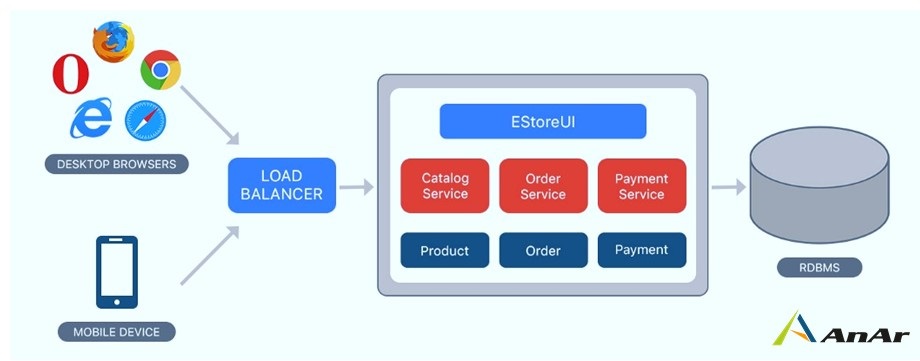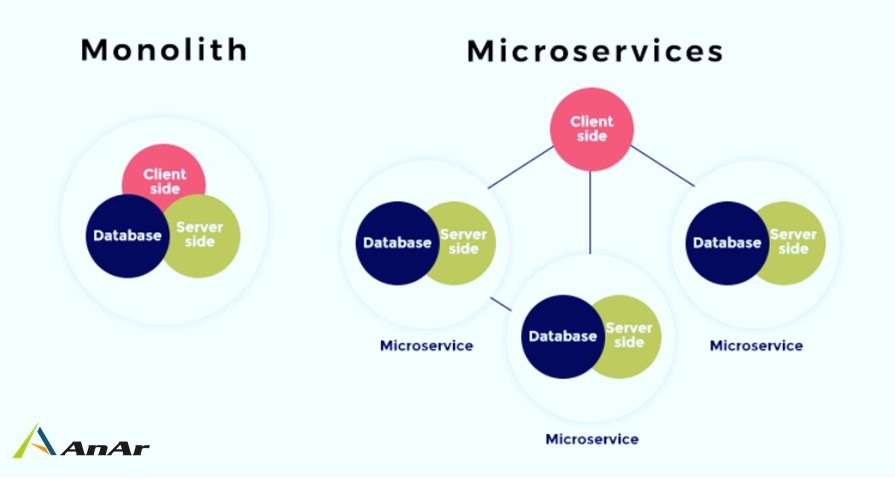In the realm of software development, evolution is the key to staying ahead. As technology advances and user demands grow, the once-revered monolith systems are finding themselves facing new challenges. The traditional fortress of code, while sturdy, is becoming a barrier to the flexibility and scalability that modern applications require. This has paved the way for a paradigm shift – a migration from monolith to microservices architecture. Join us on a journey as we delve into the dynamic transformation from the solidity of monoliths to the agility of microservices. In this exploration, we’ll navigate through the benefits, challenges, and strategies that guide this migration, uncovering how businesses are rewriting their success stories one service at a time.
Monolith systems are currently in a downtrend because of the challenges associated with large codebase, scalability, and deployment of applications. It is a conservative method of building a single and inseparable unit. A single code base is accessed by all the developers to make changes in the stack.
Microservices are in an uptrend due to the scalability and flexibility they offer in developing software. As a collection of independent units, they carry the processes of the application autonomously.
What are the benefits and limitations of Monolith & Microservices?
Organizations that have limited resources may find managing the monolith applications simpler and easier. This approach is a standard way to build applications. A single file/directory simplifies the deployments. The concern is that with an increase in size the monolith applications become tougher to manage. Each code changes affect the system as a whole. Hence, making changes is in tightly coupled huge applications is very complex.
Organizations that need flexibility in choosing the technology and need a high level of agility prefer Microservices. Initially, developers may find it complex to set up the connections between modules and databases. It also requires the independent deployment of services and testing is more rigorous.
Why migrate from Monolith to Microservices Architecture?
The unmanageable monolith application increased team size, and inability to meet business requirements call for migration. Though there is a bit of a learning curve, microservices architecture will pay off with faster development and quick launch. This is due to breaking the large applications into small parts that are easy to handle.
Microservices can be created, deployed, and even tested separately. Implementation in different languages (Java, Python, PHP) and frameworks is possible. You can choose different technology for each microservice. Microservices communicate over a network. Handle the security concerns by using open-source services like Istio that automatically encrypts the traffic between microservices.
Microservices enables organizations to comprehend the architecture. Added advantages are easy maintenance and improved time to market.
Challenges of Monolith to Microservices Migration:
- The decision of migration includes the need for iteration and handling the significant increase in application complexity. The increase in technical debt and costs of new tools, development and time invested are important decisions.
- Technically, communicating across services becomes quite difficult. At the people level, the effect of delay in development can create a greater impact on organizational goals.
- Commitment for migration needs restriction on team size and time spent. The scope of work, objectives and debugging of a new system can be prioritized. Split the large systems that include many modules in smaller independent packages of each module.
- Readiness for migration is on basis of multiple factors such as decomposition, deployment, data storage, transaction management, security, and guarantee of performance.
How to migrate from Monolith to Microservices Architecture?
The willingness to migrate or partial expertise will not be fruitful. You need the expertise of DevOps, Containers, domain modeling, and microservices architecture. Right methods for scaling, combined with engineering skills is of perfect assistance in microservice project.
- Features: Migrate features developed for business processes, operations and various teams should be evaluated to create plans. Separate from a database, the high-value components. Then push them to faster deployment cycles for migration from Monolith to Microservices.
- Components: Identify the logical components, their dependencies and then group for migration. Several analysis tools help to identify and restructure the component dependencies. These steps will lead to easy migration of macroservices to microservices.
- API for Remote Use: Create APIs for the remote user interface. Now move component groups to separate projects in smaller deployments. Propose this interface as the only mode of communication between the system, its users, and components. Taking into consideration the evolution of a system, make the interface scalable. Integrating this API allows users, interfaces, and applications to operate using this data. There is the scope of adding new attributes, objects and make them available. After setting API the new functionalities should be added through the API. Maximize the scalability with stateless API.
- Design: It is an important part of defining strategy. A well-designed microservices can curtail issues of the system. Scalability, quick defect detection and implementation are of great advantage. Consolidating multiple services is a solution to migrate more than one legacy system. The consolidation is accompanied by problems of handling data.
Strategy to migrate from Monolith to Microservices Architecture:
- Refactoring: This strategy is about implementing new functionality as services and extracting service from a monolith. Extracting the delivery services needs you to split the code, separate the delivery management with a loosely coupled module. Split the database and define a separate schema. Define a standalone and final step of the refactoring process is to remove the obsolete delivery management functionality.
- Designing Microservices: Start by designing the future microservice and changes needed in CI/CD and the testing processes. Select the code to be extracted for your app. Design the API interfaces for interaction with the monolith and other microservices.
- Setting CI/CD: Matching Continuous Integration/Continuous Delivery (CI/CD) is a must for new microservice. CI/CD is decisive while considering the refactoring of existing code. It is helpful for fast-track processing from coding till deployment. The time involved in detecting errors is reduced, letting you focus on the quality of coding and features. If existing processes do not use CI/CD processes you can introduce them in this new application.
- Implementation of Microservices: While migrating from Monolith to Microservices Architecture, the implementation pattern changes. Choose the technologies you need to use for the implementation. Technology selection is based on the type of feature, its demand and flexibility needed during operations.
- Testing of Microservices: Any migration plan needs to have a specific testing strategy. Testers can now directly interact with each microservice. Testing will have to be done at container deployment, resources, microservices interaction level and entire application. Test automation and the use of the right testing tools can ease the migration process. Adopting various testing methodologies are accurate to face the challenges and ensures reliability.
- Data Storage: Microservices maintain its own database that need not be stored on a single machine. There is no compulsion of storing the data separately even when microservices reside on separate hosts. Before data migration check data formats, data accuracy and identify missing values. Work on the treatment for available and missing data values. A central location that handles, writes, and reads data via API is effective for multiple datastores.
- Checking: Finally, the strategic plan for migration counts as successful once the reconciliation process is done. Synchronization of the system meets the set expectations. When Monolith and Microservices are compared the applications has no inconsistencies. The improvements for which you opted microservices is experienced by the end-user.
Amazon, Bestbuy.com, Coca Cola, eBay, Gilt, Netflix, Spotify, Uber are a few of the well-known companies that moved from Monolith to Microservices. They have set a clear path for others. Their experience will certainly inspire organizations with Monolith applications to try building lightweight applications.
Conclusion
Monolith to Microservices is need for an hour, it eliminates barriers to adopt new technology. Even lesser efforts deliver more, no need to rewrite the entire monolithic application. Achieving the same level of performance using microservices is difficult due to latency between services. To bring value to any business a certain level of expertise in implementing microservices is essential. You can hire a team having expertise in microservices or partner for development. Contact us to chalk out your migration plans.








